Review: Nokia C5-03: Part 2, Using the handset
Following on from our favourable look at the Nokia C5-03's hardware, it's time to take the latest budget touchscreen and see how well it works as a smartphone. It's running Symbian^1, with the standard software load, but some love and attention on the user interface, with a touch of consistency and some backporting of Symbian^3 elements, proves that the C5-03 can still surprise us.
Let's deal with the elephant in the room first of all, and the use of Symbian^1 (the Operating System formerly known as S60 5th Edition). There is a perfectly logical reason to use the 'one step previous' OS and it is this – it's cheaper.
Not in terms of licensing the OS (given that Symbian is open sourced) but in terms of hardware required to make all the bits work together. Symbian^3, as used in the N8, C7 and C6-01, demands the use of a graphical processing unit (GPU), right there you have an increase in cost per unit, and on a device such as the C5-03 that's looking to deliver a balanced performance at a low cost. Guessing that the GPU and associated supporting electronics add 40 Euros to the build cost, adding these will have a dramatic effect on the profitability of the device. Plus, once you go through the supply chain, that 40 Euros can easily multiply to 100 Euros or more. Even a single euro component can have a noticeable effect on low-end devices.

It would actually be detrimental (at this moment in time) to put Symbian^3 on a budget device. The performance would be slow and sluggish, the UI would struggle, and fundamentally there's nothing wrong with Symbian^1. Now it's reached a certain maturity in the development cycle, it's a far cry from what we saw on the first 5800's and N97's.
One of the most noticeable differences is the amount of kinetic scrolling through the UI. Apart from one or two omissions, every list has this enabled. Keeping the scroll methodology consistent throughout the phone was always my worry when a few apps picked up kinetic and not all. Well, this is what it's like when everything has it, and it's a lot more sensible. While there's no obvious “eureka” moment, the fact that you do the same thing on each screen to do the same thing makes the C5-03 easier to use than, say, the N97 mini on launch firmware, which was a bit of a halfway house.

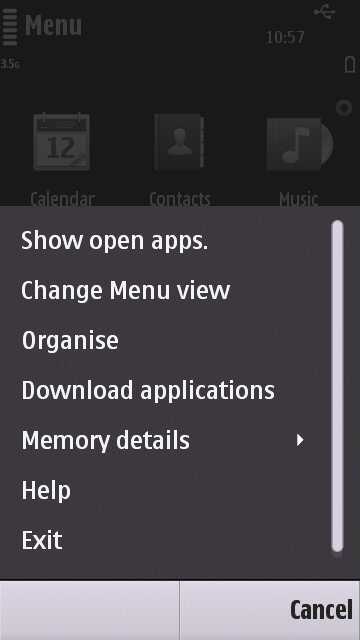
Pop up "tap'n'hold" (l) and regular menu (r)
While not as prevalent (i.e. there hasn't been a style chief go round every single option and box in the built in apps) the double tap method of selection is mostly gone. Yes, you read that right, Nokia has been back porting much of this aspect of Symbian^3's interface – one tap and you will select that item, and a tap'n'hold pops up a secondary menu of things you could do with that entry. This is much more in line with user expectations from other devices on the marketplace, and while there's no “standard” way of doing things (much as other OS fans will preach) this is close enough that I doubt people will be confused in a shop when multiple phones are offered for them to choose.
Suffice to say the user interface of Symbian^1 has not stood still while Symbian^3 has got its foot in the market. My personal opinion is that the differences in the UI's aren't that much in terms of how apps are used (there are icons, menus are called from a button strip, function and status are along the top of the screen), but I know that this is a view that people always like to debate in the comments – so carry on.
The lack of GPU does mean that you will occasionally get flashes of blank screen as everything gets worked out, and I suspect the purists will decry the phone for that, but it's not that bad. The fact that you've asked for an action as this happens means a correlation will be in the mind of the user. It's not perfect but then other OS's on mid range smartphones have the same issue.
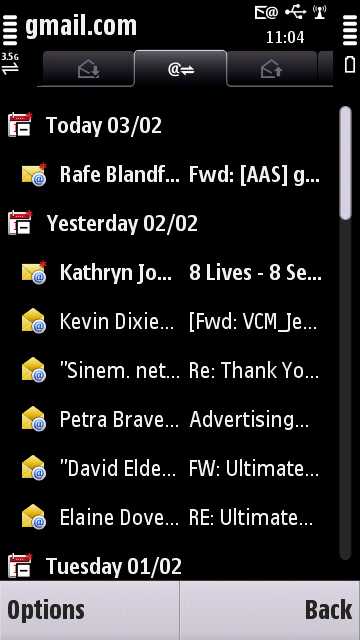
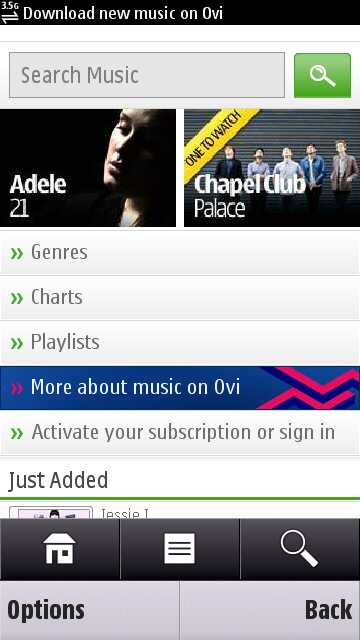
Moving back, as I have, to the C5-03 from the Symbian^3 devices, and the biggest change noticed is the return of a resistive touch screen. Part of me is glad that the C5 feels like a solid phone, and one that could take a lot of punishment, because there is no grace and delicacy possible with this screen. You need to make an not-insubstantial press on the screen to register an action. I remember this from the 5230, you need to trust the phone can take the physicality required. Unlike the svelte form of more stylish hardware, the Nokia hardware has a certain brawn to it, accept that and there's little to complain about. The underlying grid is really accurate on where you want to press, even if you end up using a big fat finger to do so. There's also something quite satisfying when banging out a quick SMS reply, the mix of speed, violence and artistry appeals to me.
Neither have Nokia pushed the boat out on the applications in the firmware. This is an utterly standard software load, which will be familiar to any previous Nokia user. That's not to say there isn't a huge amount of value here. Consider that for your £170 on an unlocked device, you're getting a fully functioning Satellite Navigation system, with A-GPS, maps and routing for the entire planet at no extra cost or monthly charge; there's a full MP3 player, with podcasting support and both FM and Internet radio applications for you to listen to, as well as one of the most comprehensive music stores on any smartphone; push email on a variety of popular email services through Ovi Mail, including Gmail, Yahoo, Hotmail (and Virgin Internet, I suspect it decided to offer me that because of my location and SIM card data); there's access to the Ovi Store to extend the functionality of the C5-03 with all the content there (including over 30,000 applications); direct access to Facebook, Twitter, Myspace and other social networks; a PIM suite to keep you in touch with the world, a solid SMS and MMS client...
There is a lot going on here, with 45 application icons available on the handset out of the box.
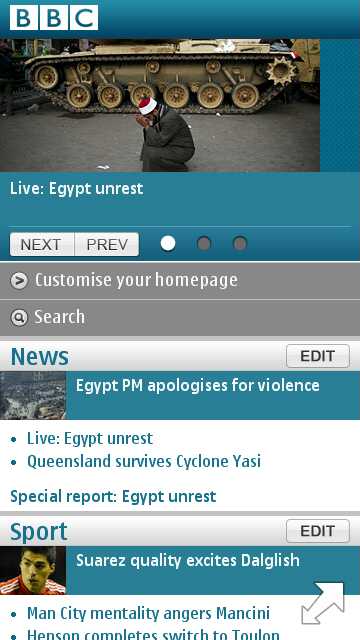

But no matter how much extra value there is, one issue is going to feature heavily, and Nokia are rapidly running out of manoeuvring room on this one. And it's the web browser. The target audience of this phone are likely to live online, and that means living in the browser. Its not that the browser doesn't work (it does) but it's not at all elegant. And while you can have a rough diamond , this is just rough. The slow evolution of the rest of the S60 UI to where it is consistent and logical seems to have bypassed the browser.
An updated Nokia Browser is something that's been trailed for the Symbian^3 devices, but its possible reliance on Qt and maybe the extra graphical oomph a GPU delivers means that it's not guaranteed to appear on the older OS. In which case Nokia need to consider doing something. To be honest every review has pretty much the same solution.
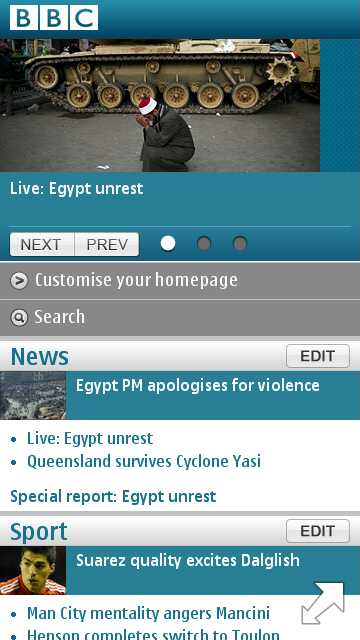
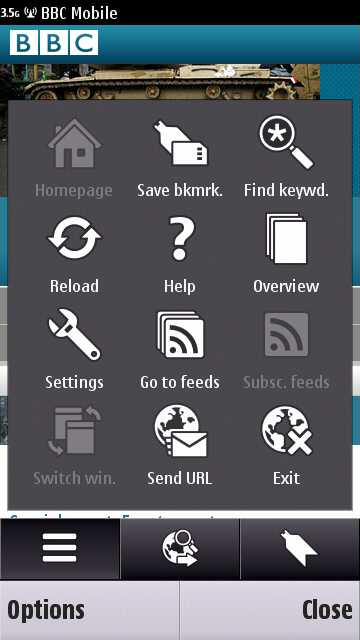
Browser layout is fine, but oh the many, many UI menus...
Get Opera (Mobile or Mini, your call) on the device. Yes, it's a free download (http://m.opera.com/) so there's nothing to stop the end user installing it if they want, and while it's not the perfect solution, it is a solution. There's also Nokia's Ovi Browser, running a similar idea of java client and proxy server to scrunch the data. This is out for S40, and perhaps an Symbian^1 version could be considered.
I'd still rather a UI polish at the very least on the native Browser though. It is needed, as it's a component part of Web Runtime, and as that's the engine for the social network applications, such as Facebook. There's no easy answer, but if Nokia are going to continue with Symbian^1 handsets - and to reach the price point they want, I suspect we'll see new phones announced throughout 2011 on this OS version – the browser issue needs resolving. One of the few advantages Android has in the low end market is a Browser that “just works”. Symbian needs the same ethos.
You can see Nokia's modern DNA through this handset. A mix of solid hardware, reliable software and services all coming together in a single handset, which makes for an attractive package - the C5-03 is already appearing on UK networks as a free handset with a £20 pay monthly contract. It's well built and rugged, and should stand up to a lot of punishment in day to day use. Having the triumvirate of 3G, Wi-fi and GPS means that the compromise you had to make when choosing the 5230 is no longer an issue, and you can pick up the handset knowing that connectivity and 'sensor' wise it's all present and correct.
There may be almost no frills to this package, but it's rather like Southwest Airlines in the US, or Easyjet in Europe. It knows it is cheap, it knows that it can't match the overall package offered by something like the JetBlue-esque Nokia N8. But it also knows that it can do everything that its customers need it to do, it can do it quickly and it can cope with pretty much anything the average user is going to throw at it.
I like Southwest, and I like the C5-03 in the same way. Sure it's nice to fly business class, have the hot towels for your face, the HDMI out ports on your phone or the 12 megapixel camera and Xenon flash (if you're not cursed with my photography skills), but a budget 737 gets you there just as quickly as an executive 737. And it's the same with the C5-03. It gets you there.
-- Ewan Spence, Feb 2011.
Reviewed by Ewan Spence at
